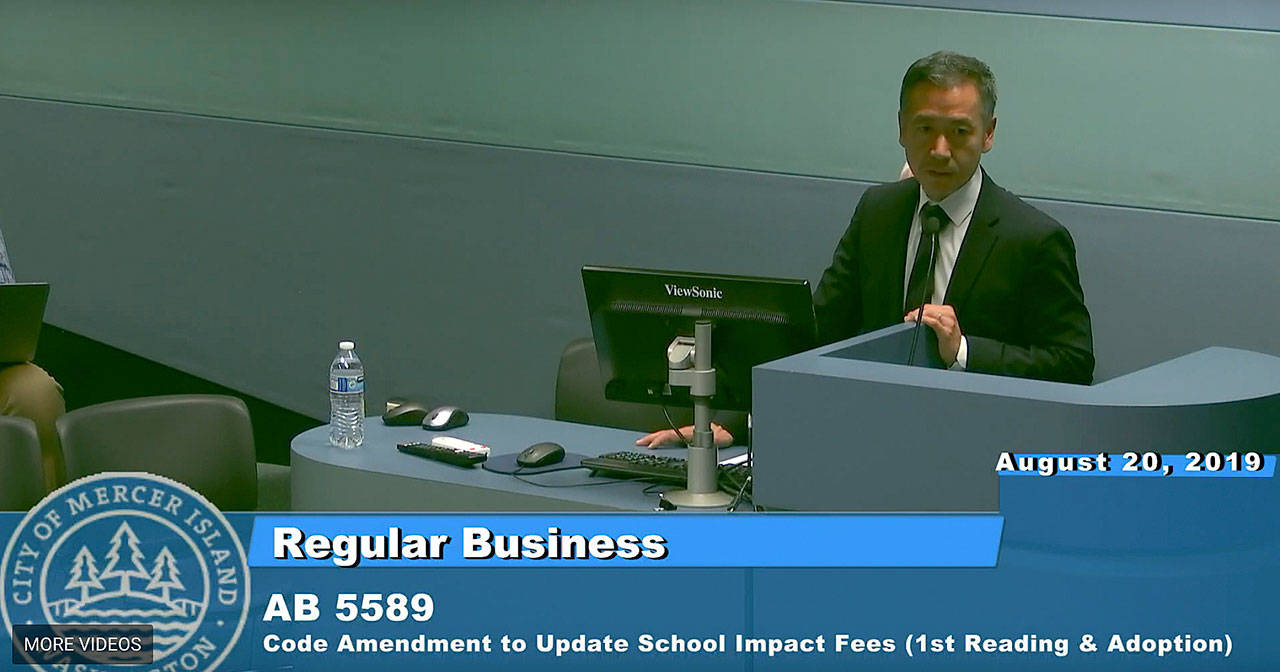The Mercer Island City Council amended city code to change the amount of school impact fees collected for the Mercer Island School District (MISD).
The council (MICC) adopted Ordinance No.19C-11 amending code 19.17.070(A) during its Aug. 20 council meeting.
School impact fees are collected from new development projects in an effort to balance the increased demand those developments bring to local schools through increased population.
School impact fees
School impact fees are used for school facilities that are addressed by a capital facilities plan element of a comprehensive plan adopted under the Growth Management Act (GMA). School impact fees are imposed on certain residential developments in accordance with MICC chapter 19.17.
The impact fees are collected by the city on behalf of the district and the amount of the impact fees are calculated and determined annually by the district in its Six-Year Capital Facilities Plan. Since first imposed in 2015, the city has collected more than $769,000 in school impact fees for the school district.
Chip Corder, assistant city manager and finance director for the city, said the city collects the school impact fees as part of the permitting process when a new a home is being built.
“We then remit what’s been collected to MISD periodically,” he said. “That’s the extent of the city’s role. To change the school impact fee amounts for a single family residential unit and a multi-family residential unit, an ordinance had to be approved by the council on Aug 20.”
According to MICC chapter 19.17.050, any impact fee imposed shall be reasonably related to the impact caused by the development and shall not exceed a proportionate share of the costs of system improvements that are reasonably related to the new development. The impact fee formula shall account in the fee calculation for future revenues the district will receive from the development.
Calculating school impact fees
In its most recently adopted Six-Year Capital Facilities Plan, the district recalculated the amount of impact fees to be imposed and collected by the city. The impact fees are currently $4,035.47 per single family residence unit and $2,632.00 per multi-family unit.
Under its most recent Six-Year Capital Facilities Plan, adopted June 27, 2019, the district requested the city to amend the impact fees to be $5,843.11 per single family residence unit and $0 per multi-family unit.
According to Tyrell Bergstrom, executive director of finance for MISD, the impact fee for the multi-family unit is $0 because two of the multi-family projects that the district was tracking for student residence “aged out” of the formula for determining impact fees. He said projects “age out” after five years.
Aviara and the Mercer, two multi-family buildings, have can no longer be used to calculate the fee because they are not impacted by growth, according to Bergstrom.
The formulas for determining impact fees can be found in Appendices A and B of the district’s Six-Year Capital Facilities Plan.
According to the district’s Six-Year Capital Facilities Plan, the formula ensures that new development only pays for the cost of the facilities necessitated by new development.
“The impact fee calculations examine the costs of housing the students generated by each new single family or multi-family dwelling unit. These are determined using student generation factors, which indicate the number of students that each dwelling produces based on recent historical data,” the Six-Year Capital Facilities Plan notes.
Furthermore, because enrollment is not projected to grow for Islander Middle School (IMS) and Mercer Island High School (MIHS), the cost basis related to IMS and MIHS were excluded from the formula.
The removal of the costs related to IMS and MIHS and the lower student factors based on the lack of residency in the multi-family projects led to a zero-impact fee rate.
The student generation factor is applied to the anticipated school construction costs, not total project cost, which is intended to calculate the construction cost of providing capacity to serve each new dwelling unit during the six-year period of the plan. The formula does not require new development to contribute to the costs of providing capacity to address the needs created by existing housing units.
According to the Six-Year Capital Facilities Plan, the construction cost is reduced by any state match dollars anticipated to be awarded to the district and the present value of future tax payments of each anticipated new homeowner, which results in a total cost per new residence of additional capacity during the six year period of the plan.
For the purposes of this plan’s construction costs, the district uses the value of each project’s contract as it was bid and authorized, with estimated adjustments for change orders during actual construction. The impact fee calculation uses the high school and elementary school capacity projects since enrollment growth over the six year planning period is projected at those levels.
Council decision
At the Aug. 20 meeting, it was recommended to the council to waive the second reading of the code amendment and adopt the amendment after the first reading.
Provisions in chapter 19.17 MICC already contemplate the possibility of changes to the amount of the impact fees based on the district’s Six-Year Capital Facilities Plan. Since impact fees are by law considered to be excise taxes, rather than development regulations, changes to the fees do not require a Planning Commission recommendation before city council adoption. The fees, in addition to being included in the city’s permit and impact fee schedule, are in MICC 19.17.070(A) consistent with state law, RCW 82.02.060(1).


